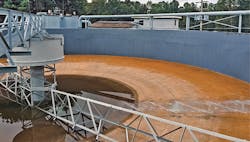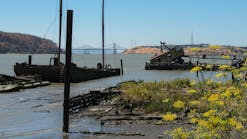As long as steel has been used for potable water storage, linings have been used to protect it from corrosion, says Davies Hood of Induron Protective Coatings. Historically, some of the different types of linings included lead-based paints, coal tar epoxies, and vinyl ester products.
Since the 1970s, however, potable water storage tanks have been largely protected by epoxy, Hood explains, and more recently zinc-rich, moisture-cured urethane products have been developed. As technology has evolved over time, the corrosion protection it offers has improved, ensuring the safety of stored potable water.
Thick-film fiberglass reinforced polymer (FRP) was introduced in the mid-1950s as an alternative to replacing tank bottoms. They were orthophthalic polyesters that bridged gaps caused by underside corrosion and were assumed to provide protection from internal corrosion as well. By the early 1960s, isophthalic polyester resins were better able to withstand aggressive corrosive conditions. Vinyl ester resins were introduced in the middle 1960s and were used, due to their expense, only in applications requiring superior corrosion resistance or toughness properties. They have a polymer that has characteristics of polyester and epoxy.
Some of the advantages of FRP systems are that they can bridge holes, with double laminates withstanding 82 psi and single laminates 37 psi. FRP linings cost less than replacing an existing steel tank bottom and the tank can be placed back into service much sooner than it could with conventional tank linings or bottom replacement with new steel. In many installations, FRP linings have a 35-plus year history of service.
When properly selected and applied, FRP linings, which are considered secondary bottoms that bond tightly to the storage tank, prevent leakage due to internal corrosion for 10 to 20 years. If the supporting steel bottom is perforated, these linings also can help minimize the problem of exterior corrosion by providing enough strength to bridge small perforations.
Even if severe corrosion is present on the outside, it is possible to apply a double layer of the laminate for a total thickness of 110 to 120 mils. (Linings of less than 20 mils dry film thickness will not protect against leakage from outside corrosion. They are recommended only for relatively new tanks with no internal pitting and underside corrosion. 1 mil is equivalent to 1/1000 of an inch.)
ONE VIEW ON NEW COATINGS
Induron Protective Coatings, headquartered in Birmingham, AL, is an industrial coatings manufacturer. It focuses on protective linings for the interior of water tanks and sewer lines. The 72-year-old company introduced ceramic epoxy technologies, used for decades in ductile iron piping, to potable water products over 30 years ago, according to Davies Hood, president of the third-generation family-owned business.
Corrosion resistance is the main focus of Induron’s work on innovative ceramic epoxy technologies for potable water tanks, says Hood. Epoxy transfers very well to the steel and concrete tank substrate, providing high film buildup since the thicker the film the more corrosive resistant the coating becomes.
Hood explains that traditional epoxy is 8 to 12 mils thick, while the ceramic epoxy Induron uses is 12 to 50 mils in one coat. The paint creates the film which provides the corrosion barrier to the tank’s substrate.
There are advantages that ceramic epoxy offers to tanks and all steel substrate. Hood says its ultra-low permeability keeps corrosion in place, away from the substrate. Its biggest advantage, however, is that ceramic epoxy provides minimal undercutting. Most coatings lose their cohesion to the substrate over time allowing corrosion cells to move by taking the path of least resistance. But ceramic epoxies have better adhesion, minimizing corrosion growth.
Hood says that ceramic epoxy coatings offer user-friendly application characteristics. They flow extremely well when applied to the inside of a tank because of the pigment make-up. Although the 100% solids version requires plural component equipment (concurrently allowing two- and three-component mixing) to apply, the low weight per gallon and minimal heat requirement allow for applications similar to traditional epoxy coatings. He adds that experience and training of technicians has a huge influence on the quality of coating applications.
Hood says, “We are big proponents of solvent-free epoxy linings.” Traditional epoxy requires two to three coatings on the inner wall of a tank. But solvent-free epoxy requires only one to two coatings. Solvents are released as the traditional epoxy coating dries, hence solvent-free epoxies are more environmentally friendly, in addition to providing improved corrosion protection and reduced chances of taste and/or odor issues.
Given that fewer coatings are needed, Hood explains that solvent-free epoxies offer a lower cost per square foot of applied materials. The cost of paint is 15% to 20% of the overall cost of a job, with labor making up the rest of the costs. Labor costs are reduced due to the reduced number of coatings needed, at the same time prolonging the life of the water tank.
Hood says polyethylene, polyvinyl chloride, and polypropylene have chemistries different from each other and are instant cures. They require a little more surface preparation and are always sprayed on. Epoxy can be applied either by rolling or spraying on. “If you have missed spots or areas of low film build, you can overcoat more effectively with solvent-free epoxy application,” he concludes.
MORE ON CEMENT LININGS
AmTech Tank Lining, headquartered in Plymouth, NH, serves three areas in the water tank lining business: potable water, wastewater, and fire suppression in sizes from 2,000 gallons to 2 million gallons. In addition, it relines chemical and petroleum tanks.
The two main systems it uses for water tanks are proprietary to AmTech: HydraStone USA cement lining and DuraChem poly lining, according to Rob Pearlman, senior CS engineer. It also repairs and relines fiberglass tanks.
HydraStone Alkrete cement lining was developed by AmTech’s affiliate HydraStone in Canada more than 30 years ago. It is used to line both domestic hot-water and cold-water tanks in hotels, hospitals, and other large businesses and institutions, Pearlman says. It is specially made to contract and expand along with the steel the tanks are constructed with. “If it didn’t, cooling and heating would fracture and disbond the concrete,” he says.
Cementitious relining is recommended when the present cementitious or thin mil epoxy lining fails. Relining the tank with HydraStone USA to 5⁄8-inch thickness will stop further erosion. If not stopped, the erosion could eventually permeate the outer steel wall and result in tank failure.
The DuraChem spray-on 580 series was developed for the potable water, wastewater, and fire suppression water industries about 10 years ago by Poly Lining Systems, which manufactures it under contract solely for AmTech, who holds the formulation rights. The DuraChem 580 series is for potable water tanks and can be applied to bolted steel, welded steel, and concrete tanks. This product can flex, bend, and stretch to adjust to changes in air temperature, sun heating, and wind deflection without disbonding from tank wall substrates. Older thin mil coatings like many epoxies can fail under these conditions, according to AmTech.
Pearlman explains that following application of an 80- to 125-mil layer of DuraChem, it becomes Tupperware-like, with tremendous adherence and bonding strength, creating an isolation wall to protect the steel or concrete substrate. He says that AmTech is constantly working in conjunction with Poly Lining Systems on new polyurethane/polyurea linings to add to the DuraChem line.
AmTech relines fiberglass tanks with fiberglass composite materials across the US. It also repairs and structurally rebuilds fiberglass tanks when tank failure goes beyond the interior surface corrosion layer. In addition, it offers fiberglass tank inspection services by its NACE- and NLPA-certified inspection staff, detailing conditions and offering recommendations. According to AmTech, the need for fiberglass tank repair and maintenance services has increased four-fold in the last two decades.
Pearlman says the company also relines wastewater treatment plant chemical tanks, which are usually fiberglass because chemicals such as sodium hyper chlorate and sodium hydroxide are so caustic. He says the wastewater treatment vessels themselves are usually made of steel or concrete substrate and can be lined with DuraChem.
AmTech says concrete tank and structure waterproofing systems have evolved greatly over the last 10 years. Topical coatings for concrete sealing can be supplemented or replaced with AmTech’s crystalline systems which, when properly applied, will embed and grow throughout the concrete structure and offer resistance to water permeation, even at extreme pressures. The crystalline processes are potable water-safe and do not wear out or weaken.
INSPECTIONS ARE CRUCIAL
The American Water Works Association developed a painting standard for steel water tanks in the 1950s and it has been regularly updated since then. By 1978, a standard for anniversary inspections was added. The current standard (AWWA D102-17) requires that the anniversary inspection be included in the contract documents and that the contractor is required to inspect the work one year after it is completed at his or her company’s expense.
Pennsylvania American Water Company repainted two 1-million-gallon standpipes in Berwick, PA. They had been last painted in the late 1980s and badly needed refurbishment. The water company contracted to have the tanks repainted in 2011. Specifications were written that required the contractor to offer a five-year material and labor warranty to repair any corrosion that was found during inspections.
The water company chose a five-year warranty rather than a one-year warranty because of its confidence in the recoating material. The interior of one tank was coated with a single coat of a 100% solids epoxy coating. The second tank was coated with a three-coat system—a prime coat of a zinc-rich, moisture-cured urethane and two coats of epoxy. On both tanks, a stripe coat of epoxy was also applied by brush to all interior seams, angles, and joints.
The five-year anniversary inspection on each tank revealed that both tanks had less than a square foot of corrosion on inaccessible interior areas. These areas were touched up. Induron attributes this result to good specifications, quality products, and a highly qualified contractor.
FABRICATOR EXTENDS TANK LIFE
Headquartered in Shawnee, OK, Fab-Seal Industrial Liners manufactures, fabricates, and installs flexible polyvinyl chloride membrane lining systems for all types of tanks including water tanks, concrete cisterns, clear well liners, underground water vaults, and pond liners for industrial users and the rural municipal utility sector in the central Midwest.
The company fabricates its liner systems in its own factory using dielectric sealing with radio frequency welding of flexible PVC membrane lining for concrete, fiberglass, steel tanks, and underground vaults, says Ken Kane, plant manager at Fab-Seal. He says the company specializes in potable water tank liners including concrete cisterns, clear wells, and underground water storage vaults.
Fab-Seal also produces leak detection monitors in which it installs valves in a water tank just above the floor. The valves can be opened on a scheduled basis to monitor tank lining integrity, Kane explains.
Kane says that many of his Midwest rural water municipal utility customers don’t have money to replace tanks. “We put in lining that extends the life of tanks.”
The materials for the company’s linings have been certified yearly since 2004 by the (former) National Sanitation Foundation, now NSF International, for Type 61 potable water and ANSI Standard 60 or 61 approval for the liners it manufactures.
A WORD ON GOVERNMENT STANDARDS
Standard Polymers, in Burlington, IA, cautioned that being aware of what government standards product options have earned is important when choosing them. “FDA Compliant” or “FDA Approved” could mean many things and the terms are used quite liberally, meaning the manufacturer complies with government requirements for what goes in their formula. “USDA Compliant” sounds good, but Standard Polymers says just about anything will pass that criterion.
MORE LINERS BEING DEVELOPED
BTL Liners, headquartered in Prineville, OR, installs geomembrane systems on tanks, ponds, and stormwater vaults, but not wastewater tanks. Clients include holding tanks for homes off the grid and government projects such as hatcheries and campus stormwater systems, according to Travis Wilcox, vice president of BTL Liners.
Since 1981, the company has been providing geomembrane systems and specialty geosynthetics. In the 1980s, BTL Liners decided to replace the typical high-density polyethylene, polyvinyl chloride, and ethylene propylene diene methylene liner products that had dominated the market for decades. That development led to the company’s creation of PPL and BTL liners. It now uses a stronger, thicker, double-scrim reinforced polyethylene material. It can be prefabricated and installed quickly, making it more cost-effective than older liner types.
BTL Liners uses reinforced polyethylene (RPE) for pond liners for irrigation and potable-grade reinforced polypropylene (RPP) to line tanks. Stormwater vaults are wrapped with reinforced polyethylene pond liners. These liners are made from environmentally friendly materials that are fish and plant safe and are certified for potable water.
UTILITY FOCUSES ON MAINTENANCE AND TESTING
The East Bay Municipal Utility District serves approximately 1.4 million people in the Northern California Alameda and Contra Costa counties at the eastern edge of San Francisco Bay and across from San Francisco. Its service territory encompasses the cities of Oakland and Berkeley. It will be 100 years old in 2023.
EBMUD’s water source is the Sierra Nevada Region watershed. Water flowing to the East San Francisco Bay is captured by a series of aqueducts and reservoirs and stored in over 130 storage facilities. Serge Terentieff, engineering manager, says the majority of EBMUD’s system, including the steel and concrete tanks, grew with population growth in the Oakland and East Bay area.
The storage facilities include 75 steel water tanks. The remainder, 30 to 40, are concrete tanks. Terentieff says the steel tanks are recoated every 25 years on a schedule of three tanks per year. Concrete tanks are not recoated, he says. Concrete is inert, and water is allowed to have direct contact with the concrete surface. The advantage is they are maintenance free. He says some concrete tanks are over 100 years old and still in use.
“Overall, we are not into linings, but instead we prefer coatings on concrete reservoirs or tanks,” says Terentieff. Some “legacy” storage reservoirs that have joints are lined, are very old, and are being replaced with concrete tanks, Terentieff says. “Concrete tanks are where we need more storage capacity, and given they don’t require ongoing maintenance, they have reasonable life cycle costs.”
Terentieff says, “Every year we review coatings and vendors approach us.” The department opens up the selection process to as many vendors as possible, he explains. “We get data sheets and the coating system they propose has to meet the NSF Standard 61 water quality standard.” The product is 100% solid epoxy. Steel tank interiors are sand-blasted to guarantee the coating will adhere, he adds.
EBMUD does its own water quality testing, Terentieff says. With the relative scarcity of water in California, water doesn’t turn over in the tanks very much, so “when we expose water to new coatings, we test it.” Andrea Pook, senior public information representative, says, “EBMUD is very conservative regarding water quality and our standards go beyond state and federal standards. Our water quality engineer and our testing lab also check for bacterial formation and film growth. We ensure the highest quality of work to protect our customers’ investments.”
The industry is evolving, says Terentieff. “Most problems with coatings are caused by applications.” He cautions utility engineers to make sure contractors apply coatings properly. There should be very strict specifications with sand-blasting steel walls, he says. “We don’t want the coatings to peel off. When we did have problems, they were in isolated portions of the tank and were caused by an application problem.”
STEADY MAINTENANCE, STABLE PRICES
Miami-Dade Water and Sewer in Florida uses 100% epoxy coatings to reline the majority of its 20 finished water storage tanks, having advanced from bitumastic coating systems, according to TJ Potok, plant operations manager. The department has successfully and cost-effectively worked with the same two products for more than 30 years, he says via email.
For more aggressive environments where the surface areas are subject to heavy erosion, such as in Miami-Dade’s three wastewater tanks, a cementitious epoxy-based material is used at greater mil thickness, Potok adds. These areas include weir walls, columns inside treatment tanks, and Parshall flumes of grit chambers, along with weir baffle wall configurations found in the effluent end of the oxygenation trains.
Potok writes, “We also have effluent pump buildings that have wet wells that require linings, chlorine contact tanks, and at the SDWWTP (Black Point) wastewater treatment plant we have filter tanks for the HLD process, which also requires a protective coating system.”
“The tanks are cleaned annually to remove accumulated sludge and biogrowth and visually inspected for coatings integrity as required by Florida Regulation 62-555.350 (regarding the operations and maintenance of public water systems),” writes Potok. They are also inspected and certified for structural and coating integrity every five years by a certified professional engineer. Potok explains, “We are currently applying several different lining systems in the same types of tanks, wells, and process facilities.





